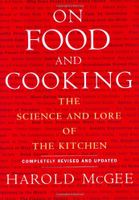Advertisement
Making Durum Pasta Dough and Shapes
By Harold McGee
Published 2004
Durum pasta is made from semolina, which is milled durum endosperm with a characteristically coarse particle size, 0.15–0.5 mm across, thanks to the hard nature of durum endosperm (finer grinding causes excessive damage to starch granules). Flat pasta shapes are punched from out of a sheet of dough. Long noodles and short thick ones are formed by extruding the dough through the holes of a die at high pressure. The movement, pressure, and heat of extrusion change the structure of the dough by shearing the protein network apart, mixing it more intimately with starch granules that have been partly gelated by the heat and pressure, and allowing broken protein bonds to re-form and stabilize the new network. Noodles extruded through modern low-friction Teflon dies end up with a glossier, smoother surface, with fewer pores and cracks through which hot water can leak in and dissolved starch can leak out. They generally lose less starch to the cooking water, absorb less cooking water, and therefore have a firmer texture than the same noodle extruded through a traditional bronze die. Proponents of traditional dies prefer the rougher surface, which they say better retains the sauce in the finished dish.


